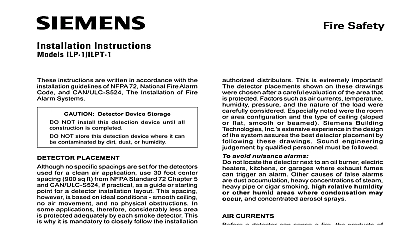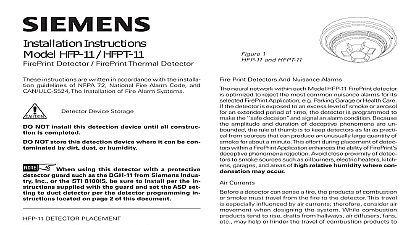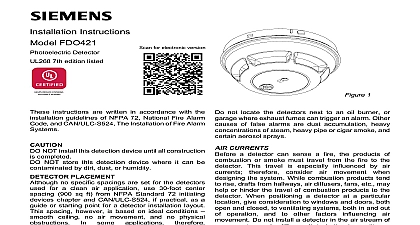Siemens FP-11 FPT-11 Intelligent Fire Detector, Installation Instructions

File Preview
Click below to download for free
Click below to download for free
File Data
| Name | siemens-fp-11-fpt-11-intelligent-fire-detector-installation-instructions-4652801793.pdf |
|---|---|
| Type | |
| Size | 682.75 KB |
| Downloads |
Text Preview
Installation Instructions FP 11 FPT 11 instructions are written in accordance with the guidelines of NFPA 72 National Fire Alarm and CAN ULC S524 The Installation of Fire Alarm Detector Device Storage NOT install this detection device until all is completed NOT store this detection device where it can be by dirt dust or humidity using this detector with a protective detector such as the DGH 11 from Siemens Industry or the STI 8100IS be sure to install per the supplied with the guard and set the ASD to duct detector per the detector programming located on pages 2 3 of this document PLACEMENT FOR FP 11 no specific spacings are set for the detectors for a clean air application use 30 foot center spacing sq ft from NFPA Standard 72 Chapter 5 and if practical as a guide or starting point a detector installation layout This spacing however based on ideal conditions ceiling no air and no physical obstructions In some therefore considerably less area is protected by each smoke detector This is why it is to closely follow the installation drawings In installations place the detector on the ceiling a of 6 inches from a side wall or on a wall 4 to 6 from the ceiling you have any questions regarding detector placement the drawings provided or approved by Siemens Inc or by its authorized distributors This is important The detector placements shown on drawings were chosen after a careful evaluation the area that is protected Such factors as air currents humidity pressure and the nature of the were carefully considered Especially noted were room or area configuration and the type of ceiling or flat smooth or beamed Siemens Industry extensive experience in the design of the system the best detector placement by following these Sound engineering judgement by qualified must be followed Print detectors and nuisance alarms neural network within each Model FP 11 FirePrint is optimized to reject the most common nuisance for its selected FirePrint Application e g Parking or Health Care If the detector is exposed to an level of smoke or aerosol for an extended period time the detector is programmed to make the safe and signal an alarm condition Because the and duration of deceptive phenomena are the rule of thumb is to keep detectors as far practical from sources that can produce an unusually quantity of smoke for about a minute This effort placement of detectors within a FirePrint enhances the ability of FirePrint deceptive rejection Avoid close proximity of detectors smoke sources such as oil burners electric heaters garages and areas of high relative humidity condensation may occur Currents a detector can sense a fire the products of com or smoke must travel from the fire to the detector travel is especially influenced by air currents consider air movement when designing the While combustion products tend to rise drafts hallways air diffusers fans etc may help or hinder travel of combustion products to the detector When a detector at a particular location give initiating of Inc unit Equip Base DB 11 or DB 3 with DB ADPT Relay Base DB X11RS or DB 3XRS with DB ADPT Next Base RLI 1 RLI 2 120 VAC 30 VDC Next Base relay contacts are shown after System reset which represents the non alarm condition 1 and Wiring Diagram Not an of Not an of Industry Inc Technologies Division Park NJ 315 095921 13 Canada Limited Technologies Division Kenview Boulevard Ontario L6T 5E4 Canada to windows and doors both open and to ventilating systems both in and out of operation to other factors influencing air movement Do not a detector in the air stream of a room air supply It is better to position a detector closer to an air distance that products of combustion or smoke travel a fire to the detector is not usually the shortest linear Combustion products or smoke usually rise to the then spread out Average ceiling heights of 8 to feet do not abnormally affect detector response High located in churches warehouses auditoriums do affect detector response and should be Ceiling Construction Factors obstructions can change the natural movement of and combustion products Depending on the direction smoke travel joists and beams can slow the movement heated air and smoke while pockets between them can a reduced level of smoke Take obstructions created girders joists beams air conditioning ducts or design into consideration when determining protection Refer to the Initiating Devices chapter of Standard 72 for Location and Spacing requirements specific types of construction e g beam suspended sloped and peaked ceilings PLACEMENT FOR FPT 11 the FPT 11 on the ceiling at least 4 inches from side walls For an ideal smooth ceiling condition place detectors at a maximum center spacing of 50 feet square feet 25 feet from side walls or room For FM Approved installations this device is compensated and has an RTI rating of QUICK Use maximum center spacing of 20 feet 400 square feet feet from sidewalls or room partitions job conditions and sound engineering judgment determine detector spacing Consider environmental including ambient temperature fluctuation and the of the fire hazard Room or area configuration and type sloped or flat smooth or beamed also placement questions arise regarding detector placement the drawings provided and or approved by Siemens Inc or by its authorized distributors This is important The detector placements shown on drawings were chosen after a careful evaluation of area being protected Siemens Industry Inc experience in design of the system assures the detector placement by following these drawings HUMIDITY PRESSURE VELOCITY operating temperature range for the FP 11 and detectors is from 32 0 to 100 38 The alarm temperature is rate compensated at 135 Use these detectors in environments where the does not exceed 93 non condensing Normal of atmospheric pressure do not affect detector For FP 11 open area 0 1200 ft min use the appropriate application from the ASD application list Use the ASD duct for 300 4000 ft min applications a in above and under floor plenums b inside an air duct c in an air duct housing using sampling tubes Follow spacing and location requirements in NFPA 72 5 for High Air Movement Areas and Control of Spread installing Model FP 11 in existing installations with existing duct detector housing order an AD 11UK Air Upgrade Kit DA 304 P N 500 695967 and use it in installation This kit includes the required housing P N 305 095676 Do not use Model FP 11 with other air duct cover air duct and open area applications the FP 11 sensitivity range is indicated on its For application sensitivity settings MXL MXLV OPERATION AND MAINTENANCE MANUAL 315 092036 the MXL IQ OPERATION AND MAINTENANCE MANUAL 315 093624 or the FireFinder XLS OPERATION AND MAINTENANCE P N 315 033744 as applicable MOUNTING ensure proper installation of the detector head into base be sure the wires are properly dressed at Position all wires flat against the base Take up all slack in the outlet box Route wires away from connector terminals REMOVAL OF DETECTOR HEAD Install Align LED in detector with LED symbol on base and detector into base Rotate detector counterclockwise whi


